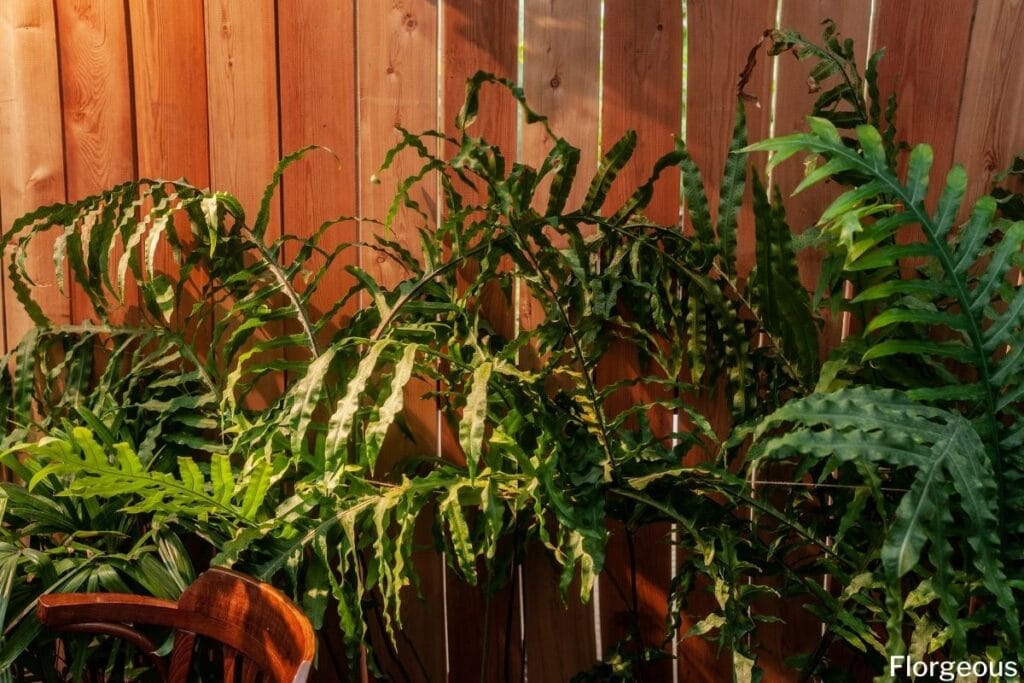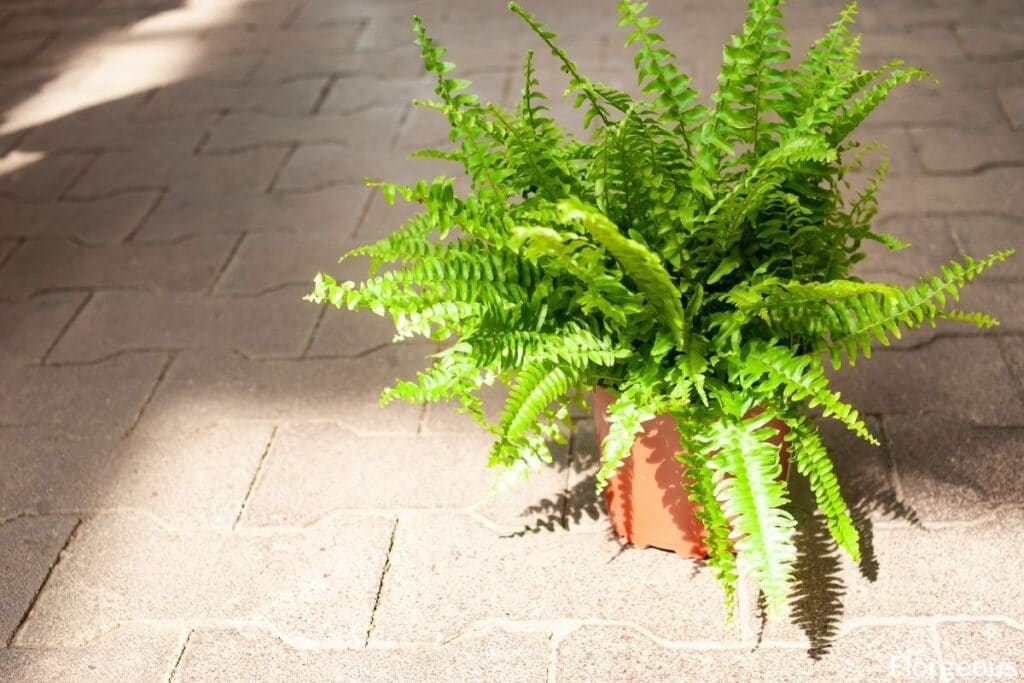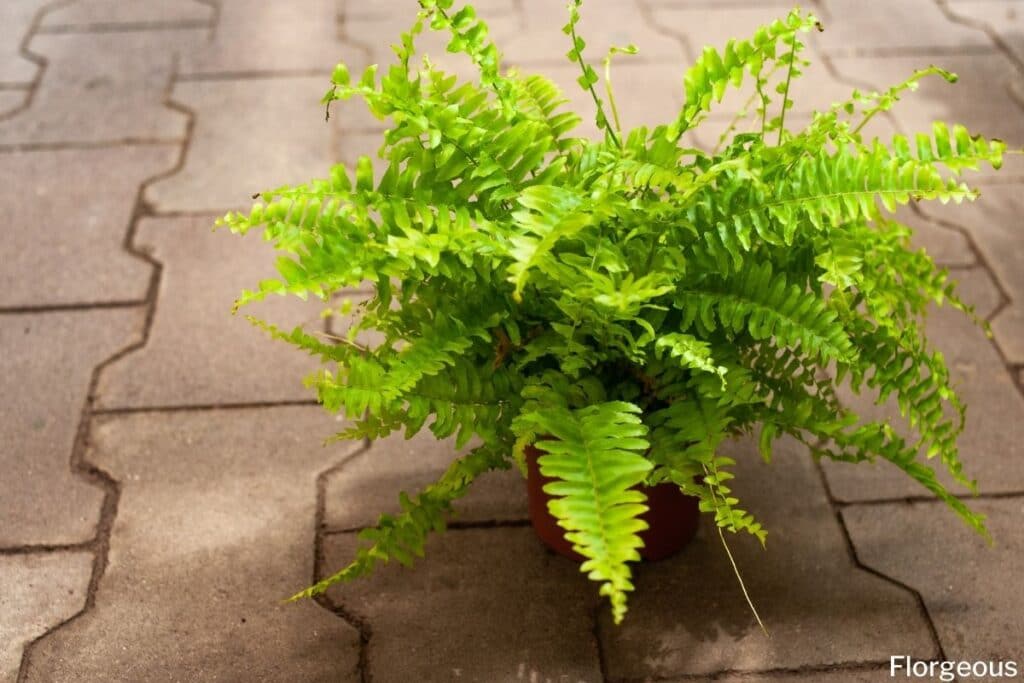Ferns are some of our favorite houseplants.
We love their luscious foliage and their low-maintenance attitude. From dramatic floor plants to trailing varieties perfect for hanging baskets, ferns can add a touch of elegance and history to any room.
Plus, did you know that ferns are one of the oldest groups of plants on earth? Their ability to adapt to various growing conditions for so many years is the perfect explanation for why ferns do so well indoors. They just keep on growing!
Keep on reading to learn about all you need to know to grow ferns indoors as houseplants successfully. With the information below, you’ll be growing your own ancient ferns in no time.
Plant Facts
| Scientific name | Polypodiophyta |
| Common names | Ferns |
| Family | Ophioglossaceae, Marattiaceae |
| Plant Type | Houseplant |
| Height and Width | Varies |
| Origin | Global Distribution |
| Flower colors | Generally without flowers |
| Foliage color | Green (usually) |
| Sun Exposure | Partial shade |
| Soil Type & pH | Well-drained, moist, often acidic soil |
| Special features | High humidity, easy to propagate, shade-tolerant |
How to Grow Indoor Fern Plants
Ferns make perfect houseplants because they do so well in containers. They can be hung from the ceiling, or used as decorations on windowsills. They enjoy the humidity of bathrooms and the filtered light of large bay windows.
They do well in a variety of different sunlight conditions and tend to be hardy. So if you forget a week of watering, or leave your plant outside during the day, they’ll most likely be perfectly fine.
Below you’ll find the most important basic information for these plants in general. However, you should always make sure to check for specific details once you decide on a certain species of fern.

Propagation
You can propagate baby ferns from spores, also known as sporangia, that take form on the undersides of the fronds. When ripe, the sporangia shed millions of spores which are dispersed by wind, water, or animals. For most species, March and July are the best months to propagate using spores.
To capture the sporangia before they disperse their spores, you can cut off a frond of your plant and wrap it in white paper. After a couple of days, you can unwrap the frond and remove it. What’s left are the spores that you plant into a new container with a growing medium optimized for ferns.
After you replant the spores, it’s best to water the container and cover it with a plastic lining to trap moisture and raise the temperature and humidity for germination.
You can also propagate fern plants using cuttings. Some species grow replicas of the parent plant called bulbils which can be rooted to grow another look-alike plant.
Fronds can be pruned off the parent plant and replanted to propagate another plant. Fronds can also be left on the parent plant but bowed and pegged into the soil nearby until they put down the fern roots. Then the propagated frond can be removed from the parent plant.
When propagating from frond cuttings, it’s best to use moisture-retentive, coir-based soil.
We also recommend keeping the fresh cuttings in a humid environment until the propagated plant has an established root system.
Soil
Most species are used to living in forests and woodlands. The soil mix in these environments tends to be loamy and rich with leaf mold, vegetable matter, and other organic substances. In addition, the soil is often light and well-draining, meaning that it is rarely waterlogged.
The potting soil you use for your houseplants should be similar. To enrich the soil you are working with, you can add organic compost to thicken and enhance it. Compost material that contains peat moss or something similar will help provide essential nutrients to the plants and allow the soil to retain moisture without becoming oversaturated.
Pruning
These house ferns do not require routine pruning. However, if you want to control the size or shape of your plant, then you may consider pruning once or twice a year. Besides that, it is nice to keep an eye out for dead or dying fronds and remove them when necessary.
If it begins to look like your plant is sick with some sort of plant disease, we also recommend pruning off the affected foliage so that whatever the sickness might be cannot spread to the rest of the plant or so other new ferns nearby.
Repotting and Transplanting
Every fern plant is a little different. Some may remain perfectly happy in their original container, depending on the growing conditions. Others may require repotting every couple of years, especially if they are planted in clay pots, which can restrict root growth more than plastic containers.
You know it’s time for repotting if you begin to see roots growing out of the drainage holes. Also if you begin to notice the plant is growing higher in the container than normal, or if the growth of the plant is stunted, it is time for repotting.
You can divide a houseplant that needs repotting to make more room and expand your houseplant collection. Dividing these plants is also a fun way to give gifts to your loved ones.
When you re-pot or transplant your potted ferns, always make sure to add additional growing soil. And to water thoroughly before and after. The best time to consider repotting and transplanting is during the early spring when the plant is beginning to put out fresh growth.

How to Take Care of Ferns Indoors
Ferns are known for making great house plants because of their low-maintenance routines. They do not necessitate a specific feeding schedule and can adapt to a variety of sunlight and water conditions.
With a little bit of research and practice, anyone can keep this kind of plant alive and thriving. Keep on reading to find the details you need to care for your indoor plants, and what to look out for in regard to pests.
Water
Most species of fern houseplants like to have evenly moist soil. Some species may be more drought tolerant than others, but in general, watering weekly should do the trick. During the hotter months of the year, your watering may increase, and vice versa during the colder, winter months.
You can check to see if your plant needs water by poking your finger about a 1 inch into the topsoil. If it feels dry, you can give your container a drink. If it still feels cool and damp, you can afford to wait a day or two.
Sunlight
In their natural habitat, ferns thrive on the dappled light that filters through the leaves of taller plants, mimicking the partial shade or indirect light found on forest floors.
Exposure to prolonged direct sunlight should be avoided with indoor fern plants because it can burn the delicate foliage. On the other hand, these plants should also not be kept in full shade, otherwise, their growth will be stunted.
A position nearby a window is a good location for growing ferns. If you are concerned about direct sunlight, filtering the light through curtains is plenty fine for ferns.
If you are concerned about your plant not getting enough light, you may consider keeping it under a grow light to extend its exposure to full-spectrum light. This will help keep your ferns happy.
Temperature and Humidity
Most ferns you will find as houseplants come from tropical and sub-tropical regions. For that reason, they prefer daytime temperatures that range between 65 and 75 degrees Fahrenheit. OVernight, they can tolerate temperatures that drop to 55 degrees Fahrenheit. Your houseplants should not be left to experience temperatures below 50 degrees.
You can protect your houseplants from cold temperatures by bringing them indoors during the winter. You can also keep them positioned in areas where they will not be exposed to cold drafts. Likewise, you should also keep them away from extremely warm temperatures like fireplaces and heating vents.
Ferns thrive in environments that have high humidity. For that reason, ferns do great as bathroom plants. If you are concerned that your houseplant is not getting enough humidity, you can mist the leaves every so often when you water the soil.
Fertilizer
Some ferns are heavy eaters and vigorous growers. If you want to encourage rapid growth, it’s perfectly fine to fertilize your plant with most any store-bought houseplant fertilizer. However, our recommendation is normally to dilute the dosage of fertilizer to about half so as to avoid any sort of chemical burn.
Fertilizing is best done at some time in early spring through mid fall. Ferns should not be fertilized during the winter months, as they are not actively growing during this time.
Pest and Diseases
Mealybugs
Mealybugs are notorious for leaching the moisture and nutrients from ferns. They feed on the joints between leaves and stems or the leaf veins themselves. A bad mealybug infestation will turn the fern fronds yellow and make them drop from the plant.
You can remove mealybugs by cleaning the plant with insecticidal soap or oil. A decent DIY solution is also to dilute rubbing alcohol with water and spray that onto your plants.
Nematodes
Nematodes are worms that cause damage to the root system underground and the foliage itself. A nematode infestation will cause lesions, stunted growth, and wilting. When foliar nematodes attack the lacy fronds of ferns, they can discolor and deform the leaves.
Getting rid of nematodes is difficult. The best thing you can do is prune the affected leaves and repot the fern into another container.
Mites
Mites can damage ferns by feeding on their leaf tissue which causes discoloration and deformity. If the mite infestation is bad enough, a bronze or rusty colored residue can be left behind on the leaves.
Insecticidal soaps or oils are often very effective at getting rid of fern mites. However, we also recommend keeping the infested fern away from other plants until the insecticide has had time to do its job.
Common Varieties and Cultivars
Here are some of the most common types of indoor ferns you can grow.
Boston Fern (Nephrolepis exaltata)
The Boston Fern is one of the most common fern varieties you will see indoors. Its light green and delicate fronds are the classic shape and size for fern foliage. In addition, these plants are popular as houseplants because they are one of the easiest species to take care of.
We especially enjoy Boston Ferns in hanging containers where their beautiful fronds can grow long and cascade downwards.
See more: Indoor Boston fern care
Staghorn Fern (Platycerium)
The Staghorn Fern gets its name from its antler-like fronds. This species is epiphytic, meaning that it grows on the surface of other objects like trees and rocks.
For that reason, these species do well when mounted onto a piece of wood. You can water the fern by soaking the piece of wood for 10 or 15 minutes. Letting it dry out between waterings is perfectly okay.
See more: Staghorn fern care
Lemon Button Fern (Nephrolepis cordifolia)
We love this variety for its delicate and precious round, button-like foliage. We also really enjoy the slight lemony scent that it can produce. Plus, it tends to be even more low maintenance than other species.
It’s not too finicky about light and can tolerate some periods of drought. It’s the perfect fern for beginners for those very reasons.
Bird’s Nest Fern (Asplenium nidus)
The Bird’s Nest Fern plant is an epiphytic fern whose fronds roughly resemble the shape of a bird’s nest. In the wild, this species typically grows on the surface of tree branches and trunks.
As a houseplant, you can mount it onto a piece of wood, a mixture of wood chips, or sphagnum moss. Generally, you should not plant it directly into the soil.
See more: How to care for bird’s nest fern
Kangaroo Paw Fern (Microsorum diversifolium)
The Kangaroo Paw Fern is an exciting species because its foliage grows in a unique way. The fronds of this fern tend to grow in different shapes and sizes, which gives it a unique and wild appearance.
The Kangaroo Paw likes routine maintenance. Moist soil, high humidity, and indirect sunlight. This fern does not disappoint as a decorative table plant or windowsill decoration.
Asparagus Fern
The Asparagus Fern, also known as Climbing Asparagus (Asparagus scandens), is a perennial, twining vine.
Originating from the humid forests of southern Africa, these airy and delicate plants have foliage resembling asparagus leaves, gracefully arching like fern fronds.
Asparagus ferns produce small flowers followed by mildly toxic berries.
Rabbit’s Foot Fern
The Rabbit’s Foot Fern (Davallia fejeensis) is a captivating fern renowned for its unique rhizomes that resemble a rabbit’s foot.
This distinctive feature adds whimsy and charm to indoor spaces, making it a popular choice among plant enthusiasts. The fern’s lush, delicate fronds grow in a graceful, arching manner, creating a soft and airy appearance.
With proper care, including regular watering and occasional misting to maintain humidity, this fern will flourish, bringing a touch of natural beauty and tranquility to any home or garden setting.
Holly Fern
The Holly Fern (Cyrtomium falcatum) is a stunning evergreen fern prized for its glossy, leathery fronds and distinctive holly-like appearance.
This fern features dark green, lance-shaped fronds that emerge from a central rosette and can reach up to 2 feet in length. It thrives in shaded or partially shaded areas and prefers moist, well-draining soil rich in organic matter.
Holly Fern is a versatile plant, suitable for both indoor and outdoor cultivation, making it an excellent choice for woodland gardens, shaded borders, or as a houseplant. With its elegant foliage and low-maintenance nature, the Holly Fern adds texture and beauty to any landscape or interior space.
Maidenhair Fern
The Maidenhair Fern (Adiantum spp.) is a delicate and graceful fern prized for its airy, lacy foliage and elegant appearance. Its fronds are composed of slender, black stems adorned with small, fan-shaped leaflets arranged in a distinctive zigzag pattern.
This fern thrives in moist, well-draining soil and prefers shaded or partially shaded areas with high humidity. While most Maidenhair Ferns are popular choices for indoor gardens and terrariums, some hardier varieties can also be grown outdoors in shady locations that mimic their natural habitat.
While they require consistent moisture and protection from direct sun light, their exquisite foliage and low-maintenance nature make them a favorite among fern enthusiasts.
FAQs
Do ferns need sunlight?
Ferns prefer indirect light or dappled shade. While some fern species can tolerate low light conditions, most require adequate indirect sunlight to thrive.
How often should you water a fern?
Watering frequency for ferns depends on factors such as humidity, temperature, and the specific type of fern. Generally, water ferns when the top inch of soil feels slightly dry, ensuring the soil remains consistently moist but not waterlogged.
How do you care for a fern indoors?
To care for a fern indoors, place it in a location with indirect sunlight, maintain high humidity levels, and water regularly to keep the soil evenly moist. Additionally, avoid placing ferns near drafts or heating vents, as they prefer stable temperatures.
How do you tell if a fern is overwatered?
Signs of overwatering in ferns include fronds turn brown, wilting, or having limp foliage. Additionally, the soil may feel excessively soggy, and root rot may develop. Adjust the watering frequency and ensure proper drainage to prevent further damage.
Conclusion
Ferns make great houseplants. Anyone, from beginners to seasoned indoor gardeners, can enjoy the simple beauty of a fern houseplant.
Ferns have survived for millions of years, and for good reason! They are not too finicky about specific light conditions, do not have strict watering routines, and can handle average temperatures. If you’re looking for fern plant care, rest assured that these resilient plants will thrive with minimal fuss.
And remember, choosing the right companion plants can complement your flowering plants and enhance the overall beauty of your indoor garden.
References
References:
University of Connecticut: Indoor Ferns
http://www.ladybug.uconn.edu/FactSheets/ferns.php
University of Minnesota: Growing tropical ferns indoors
https://extension.umn.edu/houseplants/tropical-ferns
University of Vermont: Growing Ferns Successfully Indoors
https://www.uvm.edu/pss/ppp/articles/fernsin.html
University of Wisconsin: Boston Fern, Nephrolepis exaltata ‘Bostoniensis’
https://hort.extension.wisc.edu/articles/boston-fern-nephrolepis-exaltata-bostoniensis/
Clemson University: Indoor Ferns
https://hgic.clemson.edu/factsheet/indoor-ferns/
University of Georgia: Growing Ferns
https://extension.uga.edu/publications/detail.html?number=B737&title=Growing%20Ferns
Colorado State University: Ferns
https://planttalk.colostate.edu/topics/houseplants/1307-ferns/
Close







